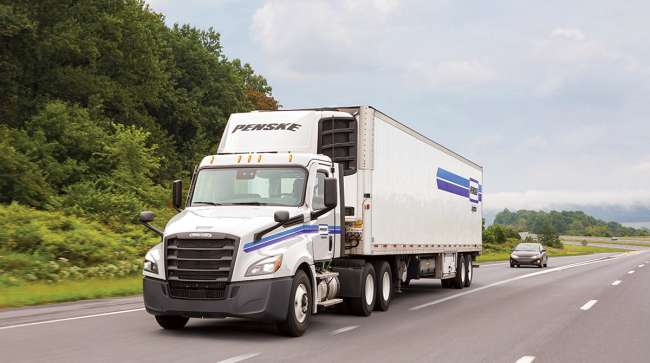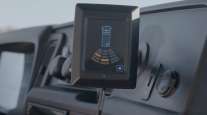Contributing Writer
Acceptance Grows for Driver-Assistance Technology

[Stay on top of transportation news: Get TTNews in your inbox.]
When Glen Kirk started driving for Old Dominion Freight Line more than 14 years ago, the truck surprised him by making a rumbling sound when he strayed too far from the center of the lane.
“The first time it did it, I was like, ‘What the crap was that?’ ” Kirk said, adding that it took some time to get used to the new driver-assistance technology since he was usually “the only thing in the truck controlling where it went.”
ODFL ranks No. 10 on the Transport Topics Top 100 list of the largest for-hire carriers in North America.
Drivers like Kirk have had to grow accustomed to driver-assistance technologies such as the lane-assist function. Quite regularly, fleets are adopting features such as lane departure warnings, collision mitigation and adaptive cruise control in order to be as safe as possible — and to protect themselves from plaintiffs’ lawyers looking to hit them with a nuclear verdict.

Jackson
Penske Logistics’ Jeff Jackson, executive vice president of dedicated contract carriage operations, said his division uses “just about everything” when it comes to safety technology for his division’s 8,000 trucks and 10,000 drivers.
Penske, which ranks No. 15 on the for-hire TT100, accelerated its fleet replacement cycle about a year ago and made a special effort to ensure 100% of its trucks are installed with collision mitigation by the end of this year. The system derates the truck and engages the brake whenever it detects a crash could occur. The transition required Penske to replace some older units sooner than scheduled. All its trucks have been equipped with adaptive cruise control for several years. That technology slows the truck to maintain a certain distance from the vehicle in front.

Taylor
Earl Taylor has been driving for Penske since 1997 with 33 years of experience. He has seen many changes.
“It seems like every time we recycle our trucks, there’s a new technology,” noting that technology is like having another trained driver in the seat. “There’s a term that truckers use about having a partner in the seat, and it was like a joke at first, but now it’s almost reality.”
Taylor said he first was hesitant to cede control, but with training it becomes second nature. He likened it to moving from a manual to an automatic transmission. He resisted at first but now can’t see himself driving a stick. Adaptive cruise was the hardest to get used to. If the vehicle in front is traveling 5 mph below the speed limit, so will the truck. An inattentive trucker can lose a lot of time. Still, it’s worth it, he said.
“We have a term, ‘The safest place is by yourself,’ and this collision mitigation and adaptive cruise helps you keep your following distance from the tractor regardless of how fast they’re going,” Taylor explained.
Driver Impact
ODFL’s Kirk believes his company’s collision mitigation technology has made him a safer driver. He’s riding a streak of 3.5 million accident-free miles and is a member of American Trucking Associations’ elite America’s Road Team. Still, he recalls two instances where a vehicle he was following suddenly slowed, and his truck slowed before he could react.

Kirk
“If you’re following somebody and they slam on the brakes, the collision mitigation in my opinion works faster than the human brain can,” he said. “By the time you see the obstacle, you perceive it in your mind that you need to step on the brakes, and then in the time you step on the brakes, I do believe that the collision mitigation works faster than the human body does.”
On the other hand, he said the technology won’t anticipate a vehicle about to turn the corner at an intersection like a human driver will.
Kirk, also a driver trainer, said some students and fellow drivers complain about the systems’ noises. His Kenworth T880 “has got a bell and a dinger for everything.” As for the collision mitigation system, “If you get within one second (of following distance), and I say this honestly, the truck, like, loses its mind. The dash starts flashing red. Stop sign comes up on the dash. It just goes berserk because it wants you to get away from the vehicle in front of you.”
Penske’s Taylor said younger drivers tend to be more receptive to the technology at first.
“I have trained a lot of drivers for new hire and refresher training, and sometimes the new hire training, because of their time in school, is easier than the refresher training,” he said. “Because some guys, they’re set in their ways, they’ve been driving for 20-30 years, and they don’t want to change.” However, he noted, “when drivers notice the benefit, they know that it makes them safer or it gets them home earlier. They buy into it right away.”
Penske’s Jackson said drivers overall accept driver-assistance technology. He also noted the company invests much energy into training and what he described as “change management.” The fleet’s field safety team often engages with drivers about the technology. So far, there has been no pushback on the collision mitigation systems, Jackson said. In fact, it’s a selling point. Penske plans to continue investing in it, he said, adding that its vacancy rate is 4%, and turnover numbers are down to pre-COVID levels.

Shepherd
A key to gaining driver acceptance is communicating with them and hearing from them, said C.R. England’s Ron Hall, vice president of equipment and fuel; and Aaron Shepherd, vice president of safety and marketing. The company’s fourth-generation owners have prioritized getting driver feedback. C.R. England ranks No. 28 on the for-hire TT100.
Executives have a monthly driver town hall conference call and a podcast where a department head answers questions. The company has its own driver road team whose trucks have a decal informing other drivers that they are a liaison with the corporate office.
“I think as a whole, drivers have been very accepting of safety technologies, maybe partially because we really explain what we’re trying to accomplish when we adopt a new technology,” Shepherd said, adding that the fleet is “very methodical” in their approach to implementation. “Our safety culture is we want our drivers and the public to get home safely, and we make investments in technology to help do that. I think our drivers are usually appreciative. In a lot of cases, drivers will bring technological ideas or products they want us to test that would even expand what our current slate of technologies are.”

Pawelski
One concern in the past has been collision mitigation systems’ tendency to register false positives. But XPO’s Greg Pawelski, vice president of health and safety, said active safety systems’ improving reliability has helped improve driver acceptance. Tim Vogt, the fleet’s driver trainer, said early collision mitigation technology would misidentify vehicles, snowbanks or signage as threats. Newer versions are more accurate. Lane departure alerts have become more accurate, but he also believes the technology has led drivers to better position their trucks to prevent the warnings from occurring.
XPO ranks No. 5 on the for-hire TT100.
“Typically, the best active safety technology operates in the background, only stepping in when a driver needs it,” he said in an emailed response.

Jones
Mauryo Jones, vice president of safety, health and security for Ryder Systems, said it started adding active safety system technology as a standard package in its internal fleet on purchases starting in 2013. Driver acceptance has increased as the technologies have improved their own experiences, she said. It has become easier as the systems have become more common in passenger vehicles. Ryder Supply Chain Solutions ranks No. 9 on the for-hire TT100.
“We’ve found that these systems can act as a driver retention and recruitment tool,” she said via email. “With advancements and continuous improvement resulting in fewer false positives, these automated assistance systems are becoming not just accepted but expected by drivers.”
Are drivers concerned the technology could lead to further advances in autonomous vehicles? No, said Penske’s Taylor, adding that the drivers he works with seldom talk about it.
Want more news? Listen to today's daily briefing above or go here for more info
“It’s been discussed, but I haven’t met a driver yet that really takes that idea totally seriously,” he said. “But we do know that it’s going to come, and guys like me thought we’d never have automatics. Whoever thought that we’d have cameras inside the truck?”
Carriers that invest in these technologies do it because it makes their fleets safer. However, technology alone isn’t enough. The best way to ensure a truck is safe remains a safe driver.
“The one message I still try to convey to everyone: It doesn’t matter what safety equipment is in the truck,” Kirk said. “Ultimately, a well-rested and alert driver is the safest thing in the vehicle. And if you don’t have that, I don’t think it matters what safety equipment is in the truck, then that’s not a safe vehicle in my opinion.”




